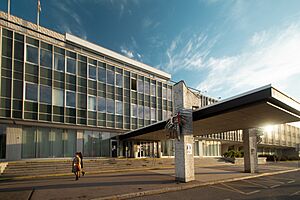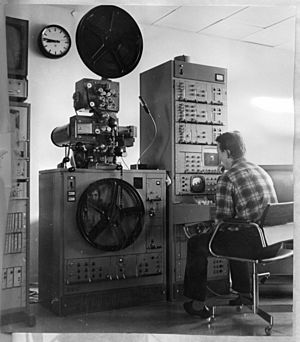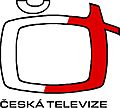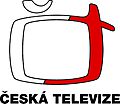Czech Television facts for kids
| Type | Public Television |
|---|---|
| Country | Czech Republic |
| Availability | National |
| Founded | by Government of the Czech Republic |
| Owner | Public |
| Key people | Petr Dvořák (Director-General) |
| Launch date | 1 January 1992 |
| Official website | http://www.ceskatelevize.cz |
Czech Television (Czech: Česká televize, often called ČT) is a public TV broadcaster in the Czech Republic. It broadcasts seven different channels. It was created in 1992 after Czechoslovakia split up. It took over from Czechoslovak Television, which started way back in 1953.
Contents
History of Czech Television
The Early Days: Czechoslovak Television (1953–1992)
Czechoslovak Television (ČST) began broadcasting on May 1, 1953. It was the official TV station for the country of Czechoslovakia. The government at the time used it to share its messages with people.
At first, ČST had only one channel. Regular shows started on February 25, 1954. A second channel was added on May 10, 1970. The first channel mainly used the Czech language. The second channel was split to show programs in both Czech and Slovak languages.
ČST's main office was in Prague. It also had studios in other cities like Bratislava and Brno.
The very first public broadcast was a short show on May 1, 1953. On February 11, 1955, they showed their first live event: an ice hockey game. Like all media back then, the station's content was carefully controlled by the government.
On May 10, 1970, ČST launched its second channel, ČST TV2. Color TV broadcasts started on TV2 in 1973. Two years later, the first channel also began broadcasting in color. In 1979, a new building for ČST's news team opened in Prague.
After November 1989, when big changes happened in the country, the channels were reorganized. The first channel became F1. The second channel split into ČTV for Czech viewers and S1 for Slovak viewers. A third channel, OK3, started for Czech audiences on May 14, 1990.
During the Velvet Revolution, ČST staff quickly supported the protesters. They helped share important messages and broadcasts of the demonstrations.
ČST stopped broadcasting when Czechoslovakia broke up at the end of 1992. Two new public TV stations were created: Česká televize (Czech Television) and Slovenská televízia (Slovak Television).
Czech Television Today
Czech Television was officially created on January 1, 1992. It became the public TV service for people in the Czech Republic. It took over the property from the old Czechoslovak Television.
On January 1, 1993, Czech Television introduced new channel names: ČT1, ČT2, and ČT3. Later, on February 4, 1994, Czech Television started broadcasting with just two channels, ČT1 and ČT2.
In 2005, a news channel called ČT24 was launched. The next year, ČT Sport for sports fans began. In 2013, two more channels were added: ČT :D for children and ČT art for arts and culture. In April 2020, ČT3 was relaunched for older viewers, but it stopped broadcasting on January 1, 2023.
The Czech TV Crisis (2000–2001)
At the end of 2000, there was a big disagreement at Czech Television. It was called the "Czech TV crisis." It was a fight over who controlled the TV station.
Reporters at Czech TV protested by sitting in the news studio. They refused to leave when new management tried to fire them. Many people, including the President at the time, Václav Havel, supported the reporters. When the protesting reporters tried to broadcast their news, their signal was often blocked. A message would appear saying, "An unauthorized signal has entered this transmitter."
The crisis ended in early 2001. The new managers left Czech TV because of pressure from public protests and the Czech Parliament.
Channels
Current Channels
| Logo | Type of programming |
|---|---|
| ČT1 is a general channel for families. It shows Czech movies, children's shows, news, and documentaries. ČT1 HD is the high-definition version of ČT1. | |
| ČT2 broadcasts documentaries, especially nature shows. It also often shows foreign movies with Czech subtitles. ČT2 HD is the high-definition version of ČT2. | |
| ČT24 is the Czech Republic's only 24-hour news channel. It provides news and information all day and night. You can watch it online and on satellites. | |
| ČT Sport is a sports channel. It broadcasts live sports events from around the world, Europe, and the Czech Republic. This includes the Olympic Games and World Cup. ČT Sport HD is the high-definition version. | |
| ČT Déčko is a children's channel for young viewers aged 4 to 12. It started on August 31, 2013. ČT Déčko broadcasts from 6 AM to 8 PM. | |
| ČT art is a channel for arts and culture. It also started on August 31, 2013. ČT art broadcasts from 8 PM to 6 AM, sharing its time with ČT Déčko. |
Former Channels
| Logo | Type of programming |
|---|---|
 |
ČT HD was a high-definition channel that showed programs from ČT1, ČT2, and ČT Sport. It was later replaced by separate HD channels for each program. |
| ČT3 showed programs, shows, and old Czech and Slovak movies. It was launched in April 2020 to help older people during the Covid-19 pandemic. It closed on January 1, 2023. |
How Czech Television Works
Television Studios
Czech Television has two main television studios. One is in Brno, which started in 1961. The other is in Ostrava, founded in 1955. These studios help create many of the TV shows you see. The government requires them to produce a certain amount of national and regional news.
Charity Work
Czech Television is known for helping many charities. They often raise money by broadcasting special programs where artists perform. For example, every year they broadcast an event for "Centrum Paraple," a charity that helps people with physical disabilities.
Education
Czech Television creates and broadcasts many educational programs. These shows are for different ages and interests. They also work with high schools and universities. For example, they offer workshops and even job opportunities for students who are finishing their studies.
European Broadcasting Union
Since 1993, Czech Television has been a member of the European Broadcasting Union (EBU). This is a large group of national broadcasters from many countries around the world. It helps TV stations work together and share ideas.
Funding and Feedback
Czech Television gets most of its money from "television concession fees." These are fees paid by households and businesses that own a TV or a device that can receive TV signals. The fee is currently 135 Czech Koruna (about €5) per month. This fee helps pay for making and broadcasting programs.
Collecting Fees
To make sure everyone pays their fees, Czech Television uses information from electricity suppliers. This helps them find households that might own a TV. If someone is found not paying, they are asked to pay the fees and an extra charge.
Feedback and Criticism
Sometimes, people wonder if Czech Television can stay fair and unbiased, especially when reporting on politics. Some groups and politicians have criticized ČT, saying it might lean one way or another. For example, former President Miloš Zeman once suggested that people who disagree with ČT should be able to send their fees to charities instead.
In 2013, the salary of a ČT director was made public. It showed he earned a lot of money, more than some top politicians.
Advertising Rules
There are strict rules about how much advertising Czech Television can show.
- On ČT2 and ČT Sport, ads can't be more than 0.5% of the daily broadcast time. This means about 7 minutes and 12 seconds per day.
- On ČT1 and ČT24, there are usually no ads. The only exception is if ads are needed to get the rights to broadcast a cultural or sports event. Even then, the ad time is very limited.
Money earned from ads on ČT2 goes to the State Fund for Culture. Money from ads on ČT Sport is used to make and broadcast sports programs. Selling products directly on TV (teleshopping) is completely banned on Czech Television.
Management
The current General Manager of Czech Television is Petr Dvořák. He was chosen for a six-year term in 2011 and again in 2017. Czech Television is a big employer in the Czech Republic, with over 3,000 employees.
Czech Television Council
The Czech Television Council supervises Czech Television. It has fifteen members chosen by the Czech Parliament. These members represent different groups and opinions in the country. They serve for six years.
The Council has important jobs, such as:
- Choosing and removing the General Manager.
- Approving the budget and financial reports of Czech Television.
- Overseeing how the budget is used.
- Approving long-term plans for programs and technology.
- Setting the General Manager's salary.
The Council has its own budget, and its costs are paid from a special part of the Czech Television budget.
Images for kids
Czech Television used the old Czechoslovak Television logo even after 1992. So, that logo was used for a very long time, from May 1, 1953, to September 30, 2012.
See also
 In Spanish: Česká televize para niños
In Spanish: Česká televize para niños
- Mass media in Communist Czechoslovakia













